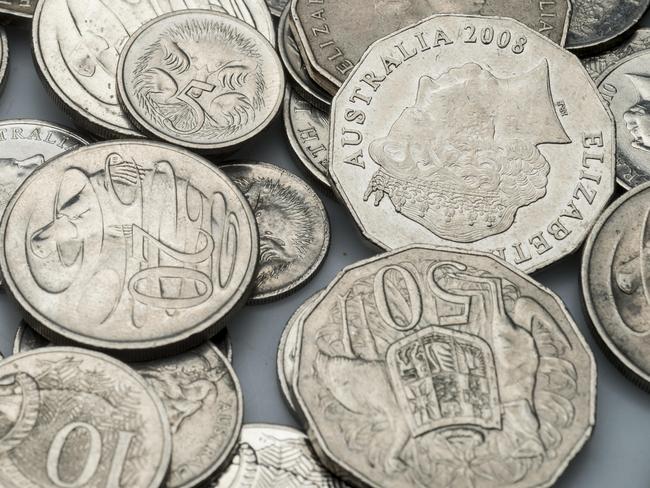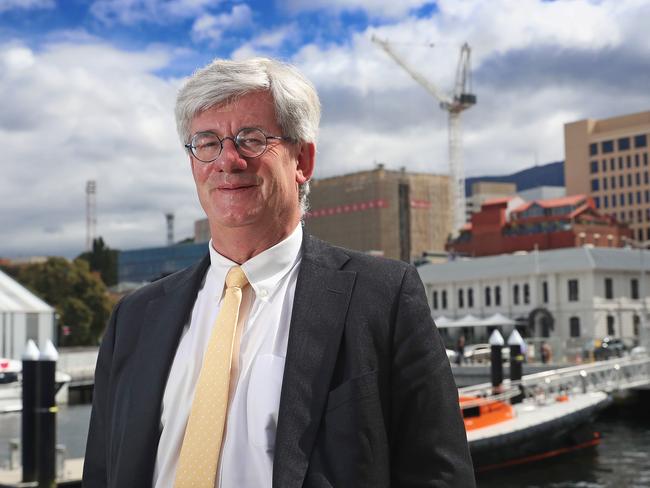GST changes give states $7.2 billion “boost”, rate won’t rise above 10 per cent, Morrison says
SCOTT Morrison has spent the day talking up his new formula for the disbursement of funds raised by the GST. Now, three of Australia’s leading economists give their verdict.
ECONOMISTS are warning Australia still needs to consider raising the GST above 10 per cent after Scott Morrison announced a new “fair go” GST distribution formula today.
The nation’s leading economists have mostly welcomed the Treasurer’s new model, which they agree will leave no state worse off thanks to $7.2 billion in “top ups” from the federal government to the states over the next eight years.
But the reform is smaller and cheaper than what the government could have introduced, they say, given the “toxic politics” surrounding GST in Australia.
It comes as Mr Morrison this morning ruled out raising the GST above 10 per cent as he announced the reform in Canberra.
He also declared there would be no new taxes imposed on Australians to pay for the $7.2 billion “boost” for the states, which will be paid from federal government coffers.
HERE’S WHAT THE ECONOMISTS SAY
PETE CALLEJA, PricewaterhouseCoopers

PricewaterhouseCoopers’ Australian tax spokesman Pete Calleja welcomed today’s reform but said the rate of the GST now needed to be examined.
The 10 per cent tax has been unchanged since the GST was launched almost 20 years ago and there has been consideration in recent years of whether to raise it to 12.5 or 15 per cent.
“Australia now has one of the lowest rates of consumption tax in the developed world. It is timely, given the period that has passed since its introduction, that we have a holistic review and debate that assesses the merits of broadening the base, raising the rate and/or seeking increases on luxury items with a decrease on essential items, for instance,” Mr Calleja told News Corp.
He said “critical reform” should not be ignored “given the evidence suggesting consumption tax is one of the most efficient tax raising mechanisms for a developed economy.”
Mr Calleja also said the states needed to make their own changes to be productive.
“It will be important however that the smaller states are incentivised to undertake much need macro and micro reforms as has been done in Victoria and New South Wales, including asset privatisation, private public partnerships, trading hours liberalisation and stamp duty reforms, to ensure these states are as productive as possible,” he said.
MORE: New laws and changes that will affect Australia from July 1
MORE: WA to benefit most from ‘broken’ GST fix

He dismissed concerns about the government including a $7.2 billion top up for the states out of its own budget bottom line, saying it was better than the “ad hoc” deals that had been done in recent years such as payments to Western Australia.
“Ensuring some of the forecast federal budget surplus is distributed to states and territories in a consistent and committed transfer mechanism will reduce the legacy issues associated with opportunistic top up deals done on an ad hoc basis, which had the perception of bias, and do not allow for long term funding of state government backed services,” Mr Calleja said.
He also said the series of significant consistent year-on-year increases to the smaller states would remove the difficulty for states of having to manage their finances based on the peaks and troughs driven by external shocks, such as WA’s mining boom.
“Any proposal that provides both an optimal increase in funding, and more certainty of funding across all states, is well overdue,” he said.
SAUL ESLAKE, ECONOMIST

Leading economist Saul Eslake has warned the states to get a guarantee that their “top up” won’t be clawed back via cuts to other payments before they sign up to the new GST system.
He told News Corp the state treasurers should seek an “explicit guarantee” that specific purpose payments, for hospitals, schools, housing or roads, wouldn’t change.
But overhaul, Mr Eslake welcomed the new model.
He said it was likely no state would be worse off and that any adverse consequences he previously thought might have flowed from changes to the system were headed off “entirely due to the Feds’ willingness to put additional money on the table”.
WA would be the biggest winner from the changes.
“The Federal Government’s proposals appear to deliver significant revenue gains to Western Australia without making any other states or territories worse off,” Mr Eslake said.
He said $4.7 billion or 70 per cent of the “top up” funding pool would go to WA.
“I think the Federal Government was absolutely correct to reject the PC’s proposals — which would have represented a substantial retreat from the longstanding principle that citizens of every state or territory should have access to similar standards of public services without being subject to vastly different levels of state taxes and charges,” Mr Eslake told News Corp.
“Implementing either of the PC’s two preferred options for transitioning to an ‘equalisation to the average’ benchmark would have cost the Federal Government between $16 billion and $24 billion over eight years to ensure that no state or territory would have been worse off — which is probably the main reason why they rejected them.”
CHRIS RICHARDSON, DELOITTE ACCESS ECONOMICS

Deloitte Access Economics’ Chris Richardson welcomed the change as a sensible reform that deserved support.
But he said the government had opted for a cheaper, smaller option than could have been implemented due to the “toxic politics” around GST in Australia.
“This is genuinely worthwhile reform but it’s small reform compared to what you’d really like to see,” Mr Richardson told News Corp.
“Fairness is great but fairness applies to people, it doesn’t apply to states. If you’re going to do the right thing by Australians, then being as fair as we are to the states gets in the way of that.
“Moving to a simpler, more sensible thing is great; it’s just that politics is so toxic these days that this is a small reform. And even it may struggle to get through.”
Mr Richardson said Australia would economically benefit from a higher GST with a broader base but said it was a mostly separate debate from today’s proposal for a new distribution model.
“I do think a bigger GST and a broader base and higher rate would be a good thing. But I do also think that’s mostly a separate debate.
“We should raise the money better in the first place. Given the money we’ve raised though, our underlying problem is essentially we decided a century ago to do it in a dumb way. We try to be fair to states, rather than fair to Australians.”
Mr Richardson said the Treasurer was technically correct in that he didn’t need the states to agree to the reform.
“But my fear is that we need all state government and all state oppositions to agree because this is an absolute barrel of monkeys with its ability to be populist.”
‘ALL STATES ARE BETTER OFF’
Mr Morrison said today the money for the $7.2 billion top ups would come from the federal budget’s bottom line, which may jeopardise budget surpluses in years to come, but he argued they were necessary to prevent any hits to the states.
“By making the pie bigger, all the states and territories benefit,” he said while announcing the overhaul in Canberra today.
“We are not increasing taxes to do this, this can be absorbed into the budget over that period of time.
“We do it in a way that all states are better off, both now and into the future.”

Mr Morrison argued there would be minimal disruption to the states by delivering the top ups, which amount to $351 million for NSW, $518 million for Queensland, $425 million for Victoria and $257 million for South Australia by 2026.
Western Australia, which has complained about the current model since its GST share fell to 30c in the dollar after the mining boom, will score about $4.7 billion more than expected in GST over the period as a result of the model changing.
Mr Morrison also defended the hit to the federal budget bottom line, which will be paid over the eight year transition to the new model, saying states would use the extra GST revenue to fund schools, hospitals, police and essential infrastructure.
“If you do it in a calm, methodical way, then there’s no sharp, sudden shock.”
Under the new formula, no state will receive less than 70 cents per person per dollar of GST by 2022. This will rise to 75 cents from 2024-25.
Mr Morrison declared there would be no strings attached the funding, meaning governments will be able to spend it as they see fit to deliver services including schools, hospitals, roads and railways.
The Commonwealth could go it alone on the GST plan, but he wants the support of each state and territory by the end of the year.
The system under which GST is shared, known as horizontal fiscal equalisation, has not been changed significantly since the consumption tax was introduced in 2000.
NSW or Victoria, whichever is higher, will be the new benchmark for the HFE.
“Benchmarking all states and territories to the economies of the two largest states will remove the effects of extreme circumstances, like the mining boom, from Australia’s GST distribution system,” Mr Morrison said.
Labor is accusing the government’s plan of having a $9 billion shortfall in what has to be doled out to the states.
Opposition leader Bill Shorten said the party would study the detail of the proposal and the Productivity Commission report before announcing a position on the GST overhaul.
“I want to make sure states have left with certainty, that they don’t have to go cap in hand to Canberra whenever they want to fund a school or hospital,” he said.
The new formula is based on recommendations out of a Productivity Commission review conducted over the last year.
The government has accepted eight out of nine recommendations. It rejected the recommendation to use an “average” figure to equalise the payments. Mr Morrison said smaller states would have been left behind if this recommendation was adopted.
Originally published as GST changes give states $7.2 billion “boost”, rate won’t rise above 10 per cent, Morrison says
